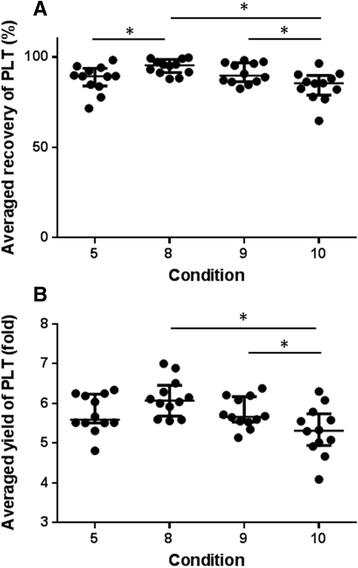Optimisation of a double-centrifugation method for preparation of canine platelet-rich plasma
- PMID: 28651609
- PMCID: PMC5485745
- DOI: 10.1186/s12917-017-1123-3
Optimisation of a double-centrifugation method for preparation of canine platelet-rich plasma
Abstract
Background: Platelet-rich plasma (PRP) has been expected for regenerative medicine because of its growth factors. However, there is considerable variability in the recovery and yield of platelets and the concentration of growth factors in PRP preparations. The aim of this study was to identify optimal relative centrifugal force and spin time for the preparation of PRP from canine blood using a double-centrifugation tube method.
Methods: Whole blood samples were collected in citrate blood collection tubes from 12 healthy beagles. For the first centrifugation step, 10 different run conditions were compared to determine which condition produced optimal recovery of platelets. Once the optimal condition was identified, platelet-containing plasma prepared using that condition was subjected to a second centrifugation to pellet platelets. For the second centrifugation, 12 different run conditions were compared to identify the centrifugal force and spin time to produce maximal pellet recovery and concentration increase. Growth factor levels were estimated by using ELISA to measure platelet-derived growth factor-BB (PDGF-BB) concentrations in optimised CaCl2-activated platelet fractions.
Results: The highest platelet recovery rate and yield were obtained by first centrifuging whole blood at 1000 g for 5 min and then centrifuging the recovered platelet-enriched plasma at 1500 g for 15 min. This protocol recovered 80% of platelets from whole blood and increased platelet concentration six-fold and produced the highest concentration of PDGF-BB in activated fractions.
Conclusions: We have described an optimised double-centrifugation tube method for the preparation of PRP from canine blood. This optimised method does not require particularly expensive equipment or high technical ability and can readily be carried out in a veterinary clinical setting.
Keywords: Dog; Double centrifugation; Platelet recovery; Platelet-derived growth factor-BB; Platelet-rich plasma.
Conflict of interest statement
Authors’ information
This manuscript is part of a MS thesis submitted by Dr. Shin to the College of Veterinary Medicine, Kangwon National University.
Ethics approval and consent to participate
All experimental dogs were housed at Kangwon National University (Chuncheon, Korea) in compliance with guidelines outlined by the Kangwon National University Animal Care Committee. The study protocol was approved by the Institutional Animal Care and Use Committee of Kangwon National University (Korea), Approval no.: KNU-160511-1.
Consent for publication
Not applicable
Competing interests
The authors declare that they have no competing interests.
Publisher’s Note
Springer Nature remains neutral with regard to jurisdictional claims in published maps and institutional affiliations.
Figures


Similar articles
-
Optimization of a rapid one-step platelet-rich plasma preparation method using syringe centrifugation with and without carprofen.BMC Vet Res. 2020 May 6;16(1):124. doi: 10.1186/s12917-020-02350-2. BMC Vet Res. 2020. PMID: 32375782 Free PMC article.
-
Use of a Cyclooxygenase-2 Inhibitor Does Not Inhibit Platelet Activation or Growth Factor Release From Platelet-Rich Plasma.Am J Sports Med. 2017 Dec;45(14):3351-3357. doi: 10.1177/0363546517730578. Epub 2017 Sep 27. Am J Sports Med. 2017. PMID: 28952781
-
Distribution, recovery and concentration of platelets and leukocytes in L-PRP prepared by centrifugation.Colloids Surf B Biointerfaces. 2018 Jan 1;161:288-295. doi: 10.1016/j.colsurfb.2017.10.046. Epub 2017 Oct 18. Colloids Surf B Biointerfaces. 2018. PMID: 29096373
-
[Methods of preparation of the platelet-rich plasma used in medicine as an accelerator of tissue regeneration].Pol Merkur Lekarski. 2014 Apr;36(214):283-6. Pol Merkur Lekarski. 2014. PMID: 24868905 Review. Polish.
-
Optimized centrifugation preparation of the platelet rich plasma: Literature review.J Stomatol Oral Maxillofac Surg. 2020 Apr;121(2):150-154. doi: 10.1016/j.jormas.2019.07.001. Epub 2019 Jul 9. J Stomatol Oral Maxillofac Surg. 2020. PMID: 31299341 Review.
Cited by
-
Platelet-Rich Plasma for the Treatment of Tissue Infection: Preparation and Clinical Evaluation.Tissue Eng Part B Rev. 2019 Jun;25(3):225-236. doi: 10.1089/ten.TEB.2018.0309. Epub 2019 May 15. Tissue Eng Part B Rev. 2019. PMID: 30712506 Free PMC article. Review.
-
Advances and prospects of platelet-rich plasma therapy in veterinary ophthalmology.Vet Res Commun. 2023 Sep;47(3):1031-1045. doi: 10.1007/s11259-022-10064-z. Epub 2023 Jan 6. Vet Res Commun. 2023. PMID: 36607500 Review.
-
Optimal frequency of platelet-rich plasma injections for managing osteoarthritis: A longitudinal study.Regen Ther. 2025 Mar 27;29:227-236. doi: 10.1016/j.reth.2025.02.006. eCollection 2025 Jun. Regen Ther. 2025. PMID: 40225051 Free PMC article.
-
Growth factor and cytokine characterization of canine platelet lysate with variable leukocyte concentration, plasma content, and heat-sensitive proteins.Front Vet Sci. 2024 Jul 12;11:1408080. doi: 10.3389/fvets.2024.1408080. eCollection 2024. Front Vet Sci. 2024. PMID: 39071789 Free PMC article.
-
Clinical outcomes following injections of leukocyte-rich platelet-rich plasma in osteoarthritis patients.J Orthop. 2019 Nov 27;18:143-149. doi: 10.1016/j.jor.2019.11.041. eCollection 2020 Mar-Apr. J Orthop. 2019. PMID: 32021021 Free PMC article.
References
-
- Kaplan DR, Chao FC, Stiles CD, Antoniades HN, Scher CD. Platelet alpha granules contain a growth factor for fibroblasts. Blood. 1979;53(6):1043–1052. - PubMed
-
- Assoian RK, Komoriya A, Meyers CA, Miller DM, Sporn MB. Transforming growth factor-beta in human platelets. Identification of a major storage site, purification, and characterization. J Biol Chem. 1983;258(11):7155–7160. - PubMed
MeSH terms
Substances
LinkOut - more resources
Full Text Sources
Other Literature Sources
Research Materials

